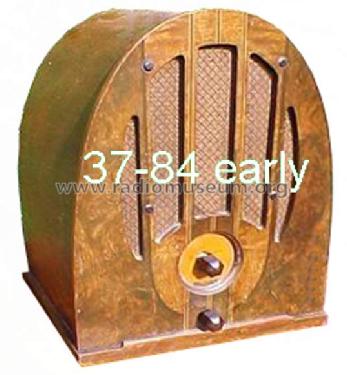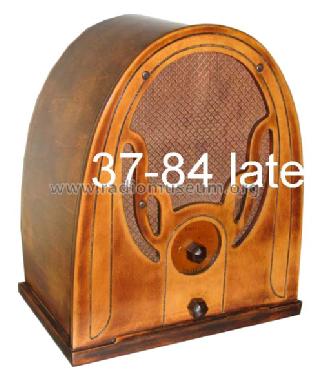37-84 G e n e r a l R e m a r k s
Philco, Philadelphia Stg. Batt. Co.; USA
- Country
- United States of America (USA)
- Manufacturer / Brand
- Philco, Philadelphia Stg. Batt. Co.; USA
- Year
- 1937
- Category
- Broadcast Receiver - or past WW2 Tuner
- Radiomuseum.org ID
- 129927
- Material
- Wooden case
- from Radiomuseum.org
- Model: 37-84 G e n e r a l R e m a r k s - Philco, Philadelphia Stg. Batt
- Shape
- Table-Cathedral-Type (upright, round top or gothic arch, not rounded edges only).
- Notes
- There are three definition fields for the 37-84 models, which cannot be correlated unambiguously:
1) The cabinets: the early type has four vertical bars in the speaker grille, while the late model does not. It features instead a two tone wood front rim (inlaid).
2) The suffix A, B, C, or none.
3) The code number. Code121 indicates the tubes 77 77 42 80, while Code122 calls for 6J7G 6J7G 6F6G 5Y4G.
Do not upload more data or photos here. !
- Circuit diagram reference
- Beitman Radio Diagrams Vol. 1, 1926-1938
- Mentioned in
- Philco Radio 1928-1942
- Literature/Schematics (1)
- Rider's Perpetual, Volume 7 = 1936 and before
- Author
- Model page created by Konrad Birkner † 12.08.2014. See "Data change" for further contributors.
- Other Models
-
Here you find 4120 models, 2229 with images and 3768 with schematics for wireless sets etc. In French: TSF for Télégraphie sans fil.
All listed radios etc. from Philco, Philadelphia Stg. Batt. Co.; USA
Forum contributions about this model: Philco, Philadelphia: 37-84 G e n e r a l R e m a r k s
Threads: 1 | Posts: 2
My first considerations to bring some light into the matter, found by investigation of following literature:
- Slusser, Coll.Guide to A.R.
- Ramirez, Philco
- Machine Age to Jet Age.
all three are referring to cabinets (with suffix)
- Rider's Perpetual and Beitman
do not use the suffixes, since the so called "Models" are represented by schematics and other service data. That allows the conclusion, that the "Model" in fact means a chassis, often being used in several different cabinets. The Code is clearly an alteration status in the course of production. It can cover few changes like tuning condenser, electrolytics, but also different tubes and their sockets (in the same circuitry).
From 1937 Philco introduced the system of leading year. For some years ist was applied rather consequently.
As it looks now: what Philco is calling "Model" seems to be in fact a chassis and "Code" is its version (called type). But we shall not ignore Philcos name"Model" ! My concern is to understand the system.
Without cabinet-suffix it means a family of models (in our understanding) embracing all cabinet styles defined by a cabinet suffix. (e.g. 37-89)
To cover all demands in search we must have pages for the "Models"(families, "Series", without cabinet-suffix) as well as those for the individual cabinet models.
Appropriate notes should go to all pages concerned.
Utmost care shall be taken by image-admins to get correct picture-model allocation. This might become a main problem, since collectors in most cases do not find the cabinet suffix at the label. They would often upload to the family. There is not the correct place, since somebody else may search for the complete name(including the cabinet suffix, e.g. 37-89F, the console) and he will fail if the image is at 37-89. His search would be overdefined for the purpose
Suffix A (followed by a cabinet suffix) appears to indicate 25 Hz power version (for Canada). Suffix E is for 230 Volt (e.g. Rider 3-40). These are not cabinet related and still to be followed by a cabinet suffix as below.
The suffix B means an upright cabinet (Cathedral or tombstone),
F, X, K, J stands for a console, C or T for a table model, CS a chairside model. (Ramirez, Slusser)
Example: 37-89B is a cathedral, 37-89F is a console.
Both models are using the same chassis/ Model 37-89 (Code 121 or other), and got the same sticker 37-89 (no suffix). Only sometimes an additional mark was made for cabinet style.
The code is allocated individually. In case of the 37-84 code 121 has a different tube lineup than Code 122. Thus two types. Unfortunately Philco put inside the cabinets labels which show the chassis only (but called "Model") and its type (= code), without reference to the cabinet.
Another example: the Model 91 series 121 and 221. In Riders the wording "91 Series" is used, which relates to chassis types, schematic, service data, parts. No cabinet mentioned, hence no relevant suffix.
Type 121 is using a single speaker, type 221 twin speaker. Called 12 and 221.
Employing a.m. "models" the following complete sets (in cabinets) are found:
- 91B = Cathedral
- 91L = Lowboy
- 91D = Highboy with doors
- 91X = Console
Any further idea? Comments are welcome (first by mail please to avoid misunderstandings).
Photos of labels and related sets would be valuable contribution to verify my theories.
KoBi
Konrad Birkner † 12.08.2014, 23.Apr.08

